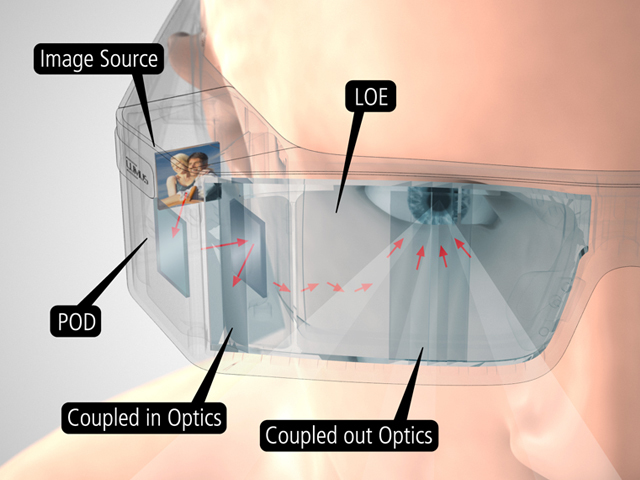Another smart glasses
 The post is dedicated to the next "smart glasses", these with LOE technology .
The post is dedicated to the next "smart glasses", these with LOE technology . After the "corporation of good" began to actively "pedal" this topic, the popularity of solutions has grown dramatically.
In particular, at the last Consumer Electronics Show 2014 in Vegas, a number of vendors were noted on the topic.
I want to talk about LUMUS , an Israeli company that has long cooperated with the local Air Force. The profile of the activity is visual and optical technologies.
They declared the DK-40 for a long time, back at CES2012 they talked about the availability of working prototypes. And finally, they presented and promise to release in March the LUMUS DK40 Glass .

LUMUS solutions are based on LOE ( Light-guide Optical Element) technology.) Is a light-conducting optical element. Its role is played by a lens made by special technology, which allows you to project a high-resolution image on it, after which, thanks to special faces, it is transmitted to the person at the right angle. Paired with LOE, the Micro-Display POD, a microprojector, plays an important role.

This is a fundamental difference from Google Glass, in which the user works with the display “hanging” in front of the eye, in LUMUS for the person, the whole lens acts as a display.
In fact, compared with Google Glass, the company offers a device with more augmented reality. The image resolution is 640 × 480 and the guys from LUMUS claim that working with their solution is comparable to viewing an 87-inch image from 3 meters.

As has already happened in the industry, the glasses are equipped with a 5-megapixel CMOS sensor, an inertial sensor (nine-axis Razor 9DOF), Wi-Fi 802.11 b / g / n and Bluetooth BLE. According to the manufacturer, the lithium-polymer battery used will provide the gadget with about 4 hours of continuous operation.
The electronic basis of the glasses is the compact processor module Varisite DART-4460 , which has a dual-core one and a half gigahertz TI OMAP4460 Cortex-A9, with integrated 2D / 3D graphics accelerator PowerVR SGX540. Its dimensions, about 1.5 × 5 cm, are ideal for such a compact form factor as glasses.

Android is used as an embedded OS, but they are not intended for stand-alone operation. Management will be carried out by the application from a smartphone or tablet.
Important point
LUMUS has no plans to bring this device to the retail market. The company works with military and industrial customers and wants to more widely promote its LOE technologies into the world. DK , in the name of the device model, stands for Development Kit, but in general they call this device Wearable Display Development Kit . And the device is intended primarily for developers, so that they understand in practice that they can have more features now. In fact, it is a development platform. An SDK for “quick start” will be included in the package.
The company hopes in this way to help third-party manufacturers adopt their technology.
LUMUS said it would be able to start shipping the DK-40 at the end of the first quarter of this year (unfortunately I could not find what price). It is focused on OEMs and for the first time will distribute a private subscription solution.
Compared with previous solutions, such as the DK-32, which were at least a little more technologically advanced (binocular 3D image in 720p), the LUMUS DK-40 - looks more focused on the mass client. According to Juniper Research, by 2018, the annual supply of smart glasses will reach 10 million pieces worldwide and LUMUS hopes to become one of the leading suppliers of components in this sector.
More ideas, more technology, higher competition: in the end, we win - users and developers.
